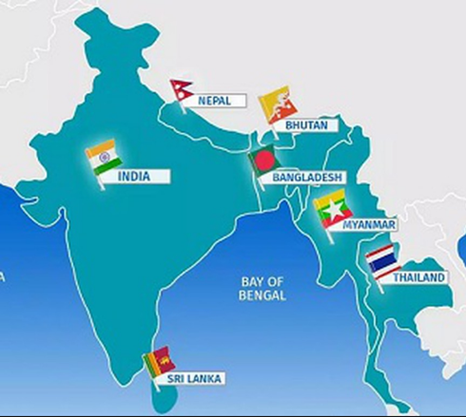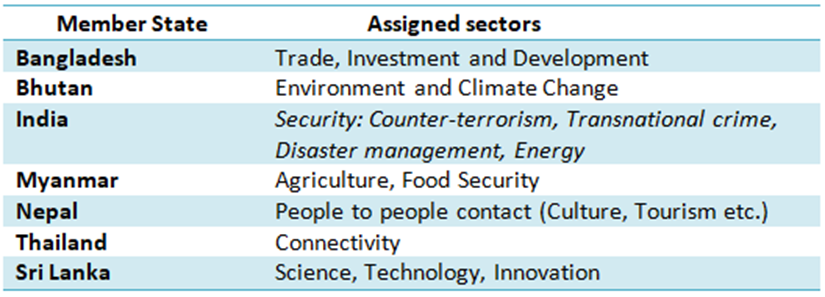Context
- 6th June, 2022 marked the completion of 25 years since foundation stone of Bay of Bengal Initiative for Multi-Sectoral Technical and Economic Cooperation (BIMSTEC) grouping was laid.
- The fifth summit of BIMSTEC was hosted by Sri Lanka in March 2022 in a hybrid fashion.
- A hybrid event is a tradeshow, conference, seminar or other meeting that combines a "live" in-person event with a "virtual" online component.
About BIMSTEC
- Description: BIMSTEC is a multilateral regional organisation established with the aim of accelerating shared growth and cooperation between littoral and adjacent countries in the Bay of Bengal region.
- Members: It has a total of seven member countries- five from South Asia, including Bangladesh, Bhutan, India, Nepal, and Sri Lanka, and two from Southeast Asia, including Myanmar and Thailand.
- Evolution: It was founded as BIST-EC, in June 1997, with the adoption of the Bangkok Declaration, with Bangladesh, India, Sri Lanka and Thailand as members.
- Expansion: It became BIMST-EC (Bangladesh, India, Myanmar, Sri Lanka and Thailand Economic Cooperation) with the entry of Myanmar in late 1997, and eventually, it was named in its current form, i.e., BIMSTEC when Nepal and Bhutan became members in 2004.
- Summit: The first BIMSTEC Summit was held on July 31, 2004 and BIMSTEC headquarters are in Dhaka, Bangladesh.

Need for BIMSTEC
- The Bay of Bengal region, was one of the world’s most integrated regions until the early twentieth century.
- But after the 1940s, when members of the region became independent and pursued separate goals and alliance systems, the region’s sense of community has almost completely eroded.
- So, the aim of setting up the regional grouping was not to create a new region for cooperation but to revive the connectivity and common interests of the members of the Bay of Bengal region.
- BIMSTEC thus constitutes a bridge between South Asia and South East Asia and represents a reinforcement of relations among these countries.
Difference from other regional groupings
- BIMSTEC is different from other regional groupings such as SAARC or ASEAN in being a sector-driven
- This means areas of cooperation are divided between members, out of the multiple sectors like trade, energy, transport, fishery, security, culture, tourism and so on.
- Unlike the South Asian Association for Regional Cooperation (SAARC), post2014, BIMSTEC has continued to hold its summits and meetings of Foreign Ministers.
- Unlike the Indian Ocean Rim Association (IORA) which held only one summit since its establishment in 1997, BIMSTEC has succeeded in holding five summits so far. It has now resolved to hold regular summits once in two years.
Renewed push by India
- Post Uri attack (on an Indian military base) in October 2016, India gave a renewed push for the BIMSTEC.
- BIMSTEC countries had supported India’s call for a boycott of the SAARC summit scheduled in Islamabad in November 2016.
- As a result, the SAARC summit was postponed for an indefinite period and India began focusing on other regional groupings such as BIMSTEC and Indian Ocean Rim Association (IORA).
Takeaways from 5th BIMSTEC Summit
- Theme: The BIMSTEC Summit 2022 theme was “Towards a Resilient Region, Prosperous Economies, Healthy People”.
- Discussions: The main topic of deliberations during the BIMSTEC Summit 2022 included:
- COVID-19 pandemic related challenges.
- Uncertainties within the international system.
- Progress of BIMSTEC as a regional group.
- Establishment of basic institutional structures and mechanisms of the group.
- Main outcome: Adoption and signing of the BIMSTEC Charter, which formalizes the grouping into an organization with an emblem, flag and formally listed principles to be adhered to.
- BIMSTEC leaders also witnessed the signing of 3 BIMSTEC agreements that represent progress being achieved in ongoing cooperation activities as follows:
- BIMSTEC Convention on Mutual Legal Assistance in Criminal Matters
- BIMSTEC MoU on Mutual Cooperation in diplomatic training
- Memorandum of Association on Establishment of BIMSTEC Technology Transfer Facility
- Connectivity: The summit saw the declaration of the ‘Master Plan for Transport Connectivity’ that would provide a framework for regional and domestic connectivity.
- India’s contribution: India will provide the BIMSTEC secretariat USD 1 million to increase its operational budget.
- Indian PM Narendra Modi called for unity and cooperation in the region as it faces economic and health challenges.
- Formal structure: BIMSTEC has prioritised the sectors of cooperation, reducing them from the unwieldy 14 to the more manageable seven, with each memberstate serving as the lead country for the assigned sector as follows:

Key achievements
- Sectoral cooperation: The grouping has also registered progress in combating terrorism, forging security cooperation, and creating mechanisms and practices for the better management of humanitarian assistance and disaster relief.
- Functional cooperation: A whole basket of memoranda of understanding, agreements and legal instruments provide the foundation for developing functional cooperation in select areas such as agriculture, trade, sustainable development and connectivity.
- Institutional framework: Institutions such as an Energy Centre and the Centre on Weather and Climate are in place to push sectoral cooperation forward.
Challenges
- The BIMSTEC region witnessed the influx of over a million Rohingya refugees into Bangladesh, the result of oppression by the Myanmar military, the coup in Myanmar that led to its virtual boycott by a large segment of the international community, and the grave political and economic crisis afflicting Sri Lanka.
The faultlines
- Trade agreements: A major failure of BIMSTEC relates to the continuing inability to produce a comprehensive Free Trade Agreement (FTA) 18 years after the signing of the Framework Agreement.
- Bureaucratic mindset: The highest political leaders, in their summit declarations, continue to direct ministers and officials to expedite action, but with little impact. This leaves the grouping largely in the hands of officials and experts.
- Connectivity: Only limited progress has been achieved so far, despite the adoption of the Master Plan for Connectivity supported by the Asian Development Bank (ADB).
- Much of the connectivity established recently is the outcome of only bilateral initiatives taken by India, Bangladesh, Nepal and Bhutan to strengthen transport links.
- Megaprojects aimed to improve connectivity between India and Myanmar (and Thailand) have been delayed inordinately.
- Blue economy: The grouping has talked about Blue Economy but is yet to begin any work on it.
- According to the World Bank, the blue economy is the "sustainable use of ocean resources for economic growth, improved livelihoods, and jobs while preserving the health of ocean ecosystem.
- Funding: For greater regional connectivity, more financial resources are needed. The movement towards establishing the BIMSTEC Development Fund is minimal.
- Corporate partnership: Business chambers and corporate leaders are yet to be engaged fully with the activities of BIMSTEC. The involvement of the ‘Third Space’ needs to be expanded significantly.
Conclusion
- At the BIMSTEC’s grouping’s birth, the world was stamped by America’s ‘unipolar moment’.
- Now in the third decade of the 21st century, the strategic contestation between the United States and China defines the region’s geopolitics and geoeconomics, creating new tensions and opportunities.
- With 7% of the world’s population and a combined GDP of USD 3.8 trillion, BIMSTEC has emerged as an influential engine of economic growth.
- The Bay of Bengal Community (BOBC) should accelerate the region’s economic development by collaborating with the newly minted IndoPacific Economic Framework for Prosperity (IPEF) creating a new synergy between BIMSTEC and the IPEF.
- Finally, while all memberstates are equal, three have a special responsibility: Bangladesh as the host of the BIMSTEC Secretariat; Thailand as the representative of Southeast Asia; and India as the largest state in South Asia.
- This trio must be the engine to pull the BIMSTEC train with imagination and determination with a determined push at the highest political level as evident in 5th summit in March 2022. That is the key lesson from the past.









